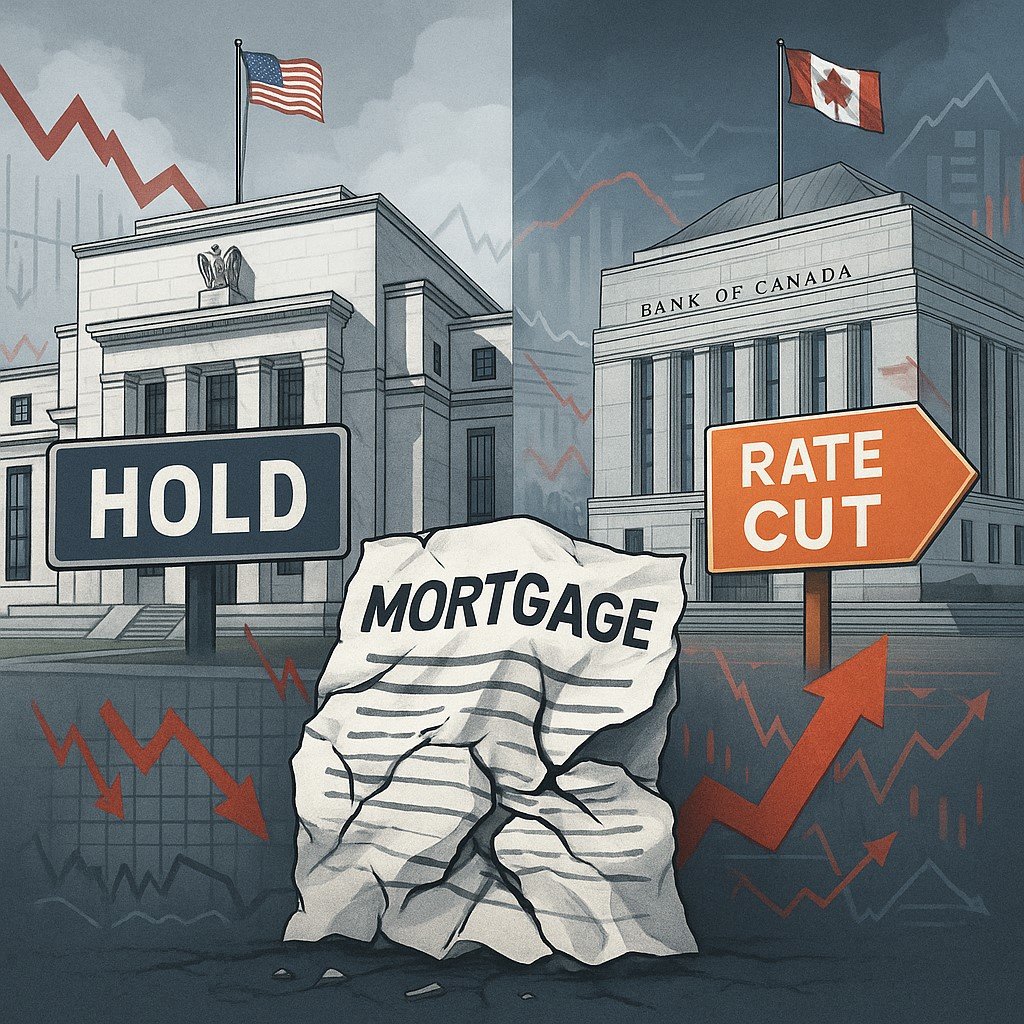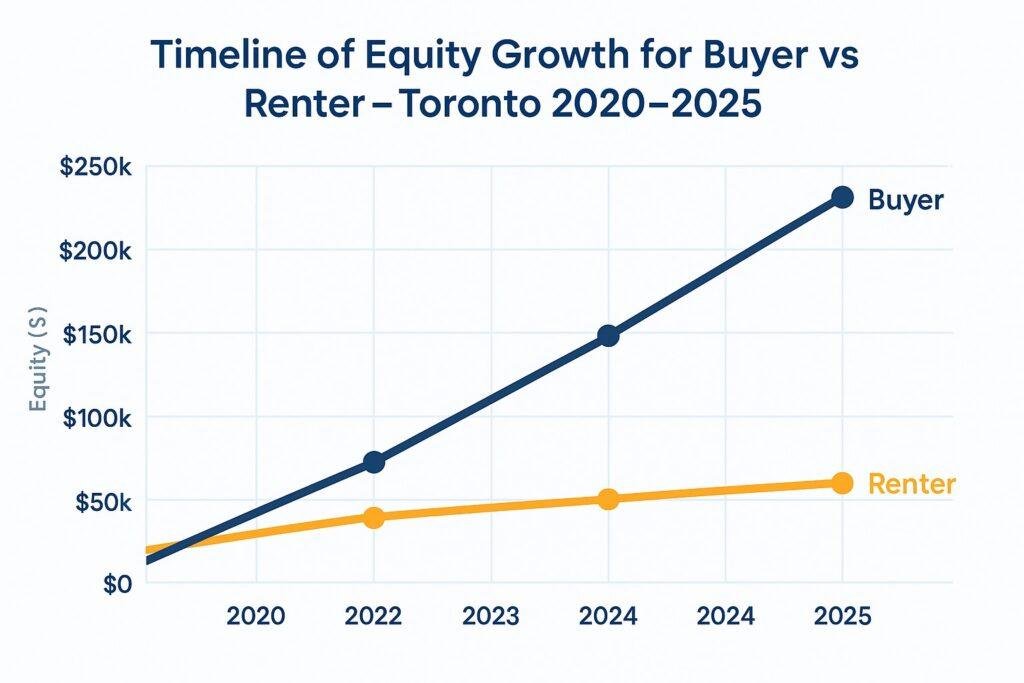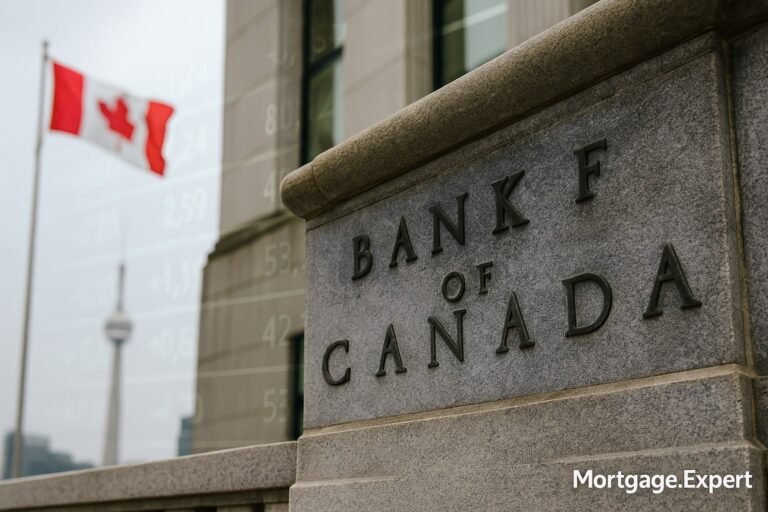
Canadian Mortgage Market Risks Deepen As U.S. Fed Holds While BoC Cuts Rates
Canada’s mortgage market faces growing risks as the U.S. Federal Reserve holds interest rates while the Bank of Canada begins rate cuts. Here’s why the divergence matters.
The Canadian mortgage landscape is going through some serious turbulence. And a big part of the reason? The growing gap between how Canada and the U.S. are handling their interest rates and currencies.
As the Bank of Canada (BoC) continues to cut its policy rate to stimulate the economy, the U.S. Federal Reserve is taking a different route—choosing to hold firm. This widening policy divergence is doing more than just moving numbers on charts. It’s reshaping mortgage rates, homebuyer confidence, and even the value of the Canadian dollar. Let’s break down what’s happening, what it means for Canadian homeowners and buyers, and how to adapt in this shifting environment.
Bank of Canada Slashes Rates, While the U.S. Holds Steady
In its latest announcement on January 29th, the Bank of Canada lowered its overnight rate to 3.00%, marking the sixth consecutive cut in its attempt to boost economic activity. This move officially signals an end to Canada’s quantitative tightening era and a pivot toward more expansionary policy.
Across the border, however, the Federal Reserve is standing pat. Its benchmark rate remains steady at 4.25%–4.50%, creating a stark divergence between the two central banks. And that divergence is putting pressure on the Canadian dollar—driving it below $0.70 USD for the first time in years.

📉 How Canadian Rate Cuts Influence Mortgage Markets and Currency Trends
1️⃣ Monetary Policy Shift
🏛️ Bank of Canada: Rate cut to stimulate the economy
US Federal Reserve: Holds interest rates steady
2️⃣ Currency Reaction
💱 Canadian Dollar Weakens: Loonie falls below $0.70 USD due to interest rate gap and market outflows
3️⃣ Mortgage Market Impact
- 🏠 Variable Rates Drop – Lower payments for some borrowers
- 🛡️ Fixed Rates Volatile – Lenders hesitant due to bond yield uncertainty
- ⚠️ Risk Premiums Rise – Lenders price in higher borrower risk
📌 This infographic illustrates how interest rate policy divergence affects both currency value and mortgage dynamics in Canada.
How This Policy Split Is Affecting Mortgage Markets
The growing gap in interest rates between the U.S. and Canada is sending ripple effects through our economy—especially the housing and mortgage sectors.
When the Bank of Canada cuts rates and the U.S. doesn’t, investors start moving capital away from Canada. The result? A weaker loonie. In fact, in 2024 alone, the Canadian dollar depreciated by over 7.7%, and much of that was driven by these diverging policies.
Why does this matter to you? Because a weaker currency makes everything we import more expensive—including food, fuel, and construction materials. That drives up inflation just as the BoC is trying to lower it with rate cuts. It’s a tug-of-war—and borrowers are stuck in the middle.
Variable Rates Are Dropping, But Fixed Rates? Not So Fast
For Canadians on variable-rate mortgages, the BoC’s cuts have been good news. Monthly payments are going down as lenders adjust prime rates. For example, after the January cut, Canada’s prime lending rate is expected to drop from 5.45% to 5.20%, offering relief for many borrowers.
But it’s a different story for fixed-rate mortgages. Those are tied more closely to bond yields—and bond markets are still jittery. The fear is that inflation could rise again if the dollar stays weak or if tariffs come into play. That makes lenders cautious, which means fixed mortgage rates may not fall as quickly—or as much—as expected.
Lenders are also adding higher risk premiums to new mortgages, especially fixed-rate ones. These premiums act like insurance in case job losses rise, home prices fall, or a trade war weakens the housing market.
📈 Mortgage Risk Premiums: How They Work & Why They’re Rising
🏦 What Are Risk Premiums?
Lenders charge a small extra percentage on mortgage rates to protect themselves against borrower risk. This is known as a risk premium.
🔄 Why They’re Rising:
Economic uncertainty like rising unemployment, home price drops, and trade disruptions make lenders nervous. In response, they raise premiums to shield against potential losses.
📊 Impact on Borrowers:
These premiums can add anywhere from 0.25% to 0.75% on top of your fixed mortgage rate—even if central rates are falling.
🛡️ Example:
A borrower approved at 4.00% may actually be offered 4.50% due to market risk conditions.
Tariff Threats From the U.S. Could Escalate the Damage
If you think the currency gap is the only issue—think again. In early 2025, former President Donald Trump threatened a 25% tariff on all Canadian imports, with more protectionist measures on the way.
That’s not just political posturing. According to the BoC’s January 2025 Monetary Policy Report, a full-blown trade war could wipe out 2.4% of GDP in the first year and 1.5% the next. That would be a major hit to our economy—and potentially our housing market too.
So even though mortgage rates are falling, the bigger economic picture remains cloudy. Inflation may climb due to rising import costs, while job growth could stall. It’s the worst of both worlds—a potential stagflation scenario.
📉 Projected Impact of Tariffs on Canadian GDP (2025–2026)
| Year | No Tariffs (Projected Growth) | With Tariffs (Projected Drop) |
|---|---|---|
| 2025 | +1.2% | –2.4% |
| 2026 | +1.5% | –1.5% |
Tariff-driven slowdowns could reduce Canada’s GDP growth by up to 2.4% in 2025 and continue weighing down the economy in 2026.
📦 How Tariffs Increase Inflation While Slowing Growth
1️⃣ Tariffs Introduced
🏛️ Government imposes tariffs on imported goods, raising costs at the border.
2️⃣ Immediate Effects
- 🚢 Import Costs Rise: Imported products become more expensive
- 🏭 Business Input Prices Increase: Manufacturing becomes costlier
- 🛒 Consumer Prices Go Up: Shoppers pay more for daily essentials
3️⃣ Economic Drag
- 👛 Reduced Consumer Spending: Households cut back on expenses
- 📉 Slower GDP Growth: Overall economic momentum weakens
- 💼 Job Market Weakens: Businesses reduce hiring or lay off workers
Tariffs may protect domestic industries short-term but often cause higher inflation and slower growth, affecting everyone from homeowners to homebuyers.
The Currency Angle: Why the Loonie Is Under Pressure
The Canadian dollar’s value is heavily influenced by interest rate differentials with the U.S. Normally, a 1% gap between BoC and Fed rates would cause about a 1% drop in the loonie. But in 2024, the decline exceeded that model.
Why? Because of growing risk premiums. Investors are worried about trade instability, political uncertainty, and long-term inflation. That leads them to bet against the loonie, driving its value down further.
This has direct effects on mortgage borrowers. For one, home construction materials imported from the U.S. or China become more expensive. This could push up the price of new homes or renovations—even as interest rates drop.
📊 CAD/USD Exchange Rate vs BoC Rate Cuts Timeline (2023–2025)
| Quarter | BoC Rate (%) | CAD/USD Rate |
|---|---|---|
| Q1 2023 | 4.50% | 0.75 |
| Q2 2023 | 4.25% | 0.74 |
| Q3 2023 | 4.00% | 0.73 |
| Q4 2023 | 3.75% | 0.72 |
| Q1 2024 | 3.50% | 0.715 |
| Q2 2024 | 3.25% | 0.710 |
| Q3 2024 | 3.00% | 0.705 |
| Q4 2024 | 3.00% | 0.695 |
| Q1 2025 | 3.00% | 0.690 |
| Q2 2025 | 3.00% | 0.685 |
| Q3 2025 | 3.00% | 0.680 |
| Q4 2025 | 3.00% | 0.675 |
As the Bank of Canada consistently lowered its policy rate, the Canadian dollar depreciated against the U.S. dollar—highlighting the impact of monetary divergence.
What Should Homeowners and Buyers Do Now?
In this environment, there’s no one-size-fits-all mortgage strategy. But here’s how different borrowers might want to approach the current climate:
If you’re shopping for a home this spring, variable-rate mortgages offer some of the best savings right now. Monthly payments are coming down, and there’s potential for more cuts. But remember, if inflation resurges or trade tensions boil over, rates could rise again down the road.
If you’re thinking about a fixed-rate mortgage, know that pricing may remain sticky. Lenders are cautious, and they’re pricing in risk—even if the BoC continues to ease. Watch bond yields closely if you’re planning to lock in.
If your mortgage is up for renewal or refinancing, this is a window to review your options. Fixed rates may still be higher than you’d like, but you can take advantage of better terms now compared to early 2024. A blended or short-term fixed product might be worth considering.
Final Thoughts: Stay Informed, Stay Flexible
With Canada and the U.S. taking opposite approaches to monetary policy, the mortgage market is likely to remain unpredictable through 2025. The BoC’s decision to cut rates may give borrowers short-term relief, but bigger risks loom—especially if the loonie continues to fall or if trade disputes escalate.
The key takeaway? Stay flexible and proactive. Whether you’re buying your first home, renewing your mortgage, or considering a refinance, now is the time to explore your options and seek out trusted, unbiased advice.
🏡 Talk to a Canadian Mortgage Expert
Unsure about your mortgage options in this shifting market? Get free, unbiased advice from a licensed expert near you.
Understand Your Rate Options TodayStuck with a Mortgage Decision?
Don’t stress — our team is here to help. Reach out for free, no-obligation guidance.
Contact the Experts



